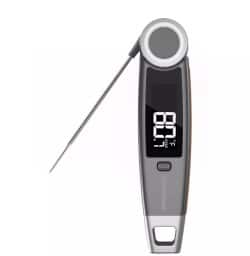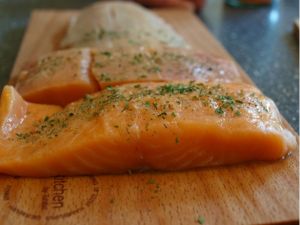
Smoked Salmon: Key Temperatures for Success
It’s not enough to buy smoked salmon from the market, even though it saves you money and time. However, it’s not every time you have to buy a smoked salmon. What if there is no smoked salmon? How can you smoke the salmon at home?
You need to know how to smoke your salmon like a professional. If you are already thinking this way, you are at the right place because we will guide you on smoking your food. With your smoker thermometer, you can prepare your salmon excellently, knowing when it is done.
Nowadays, people are not perplexed when preparing fish because of the knowledge of food safety temperature and refrigeration. It is safer to eat than some years ago. In this write-up, you will learn the essential temperatures and tips required to ensure your smoked salmon has that fine texture and rich flavor.

Table of Contents
How to prepare your smoked salmon?
While there are several ways of preparing your smoked salmon, we believe the best way to start is by curing your salmon. This doesn’t mean you should not learn how to use a meat thermometer. A meat thermometer can come in handy, especially when you want to know the internal temperature. Importantly, you need to know the doneness of your salmon or meat.
Curing your fresh salmon
If you want to do something, it’s worth doing it rightly. Therefore, salt curing the salmon is the first step. Using a little sugar and salt can add some flavor to your fish. However, have you thought about what goes on under the surface? Salt curing is the process of packing fish in a dry mixture of sugar and salt while smoking it to preserve it.

Let’s take a scientific exploration while you wait for the salt to drive deep into the salmon. When you salt a fish, it draws its moisture, including microbial cells. During this process, unwanted bacteria die because of the salt, whereas beneficial bacteria come to the front, consuming the sugar. The good bacteria (lactobacillus) grows and generates a more acidic environment, making it unfriendly for any harmful bacteria.
Why smoke your salmon fish?
One reason for smoking fish and meat is to preserve them. It’s necessarily not essential to add smoky flavors. When you use wood smoke, it slows microbes’ growth because of the chemicals in the wood smoke. Furthermore, these antimicrobial compounds act as sterilizers to slow rancid flavors’ growth and prevent spoilage.
Pellicle formation
Let’s take a step forward to our exploration before looking at how to smoke salmon. During the curing process, water-soluble proteins are brought to the fish surface. After curing, the surface moisture of the salmon dries, which develops a gummy and glossy gel on the surface known as a pellicle.
The function of the pellicle is to enable the salmon to retain its moisture while aiding smoke to penetrate during cooking. Without your salmon developing this tacky skin, it will get scorched. You will see how important this is when we go through the recipe. Welcome back from your little expedition.
Understanding the heat difference between cold and hot smoking

You can either use cold or hot smoking when smoking your salmon fish. The essence of cold smoking is to preserve it while the cooking temperatures remain within 20-30°C (68-86°F). The process can stay for 6 to 12 hours as the salmon flesh losses its moisture and get denser without cooking it. However, the outer part of the salmon remains soft instead of being hard as when it was cooked under high temperatures.
Nevertheless, there is a drawback to cold smoking your fresh salmon because it stays within the temperature danger zone (4-60°C or 40-140°F) for several hours. We recommend you don’t use this method, especially if you don’t want your meat to stay within that temperature danger zone. You can use an instant-read thermometer to check if the meat is above or below the danger zone.
On the other hand, hot smoking occurs within the temperature range of 66-77°C (150-170°F). Allow the fish to get smoked pending when it reaches the desired temperature level. Remember, you need a smoker thermometer to check the doneness of a fish instead of manually relying on your eyes. To kill existing microbes, you need a higher temperature to help guarantee your salmon is safe for consumption.
Note: To ensure you keep your salmon within the recommended temperature, you need to buy the best cooking thermometer with a low alarm and an air probe. Furthermore, you can use a steak temperature chart to know the ideal temperature for your meat or fish.
How to smoke salmon – the Chefstemp method?
Ingredients required
- 1 lb of salmon fillet(s)
- At least 3 cups of water
- ½ teaspoon of lemon zest
- ½ cup of grounded sea salt
- ½ teaspoon of dried dill
- ½ teaspoon of Colman’s mustard powder
- ½ teaspoon of black pepper

Step One – Curing your fresh salmon
Take the water and salt and put them into a saucepan under medium heat. Ensure you stir the mixture to enable the salt to dissolve properly. Avoid boiling the solution; place the fresh salmon into a glass baking dish and cover it inside the solution. Allow it to stay for 24 hours in the refrigerator.
Step Two – Mix your ingredients
Remove the salmon from the solution after 24 hours and use cold water to rinse it. In addition, use paper towels to pat it dry. Furthermore, mix the black pepper, mustard powder, lemon zest, and dill. Take the mixture and rub throughout the salmon’s skinless side. Ensure you allow the seasoned salmon to stay in the refrigerator for 2 to 4 hours to form the pellicle.
Step Three – Preheating your smoker
You have to preheat your smoker to 66°C (150°F). You can use the ChefsTemp Finaltouch X10 Instant Read Meat Thermometer to track the internal temp of the salmon and interior smoker temperature. Ensure you secure the air probe using a grate clip. If your kitchen thermometer comes with an alarm setting, you can set the high alarm to 71°C (160°F) and low to 60°C (140°F). For the smoke, you can opt for hardwood wood chips.
Step Four – Smoking your salmon
With your pellicle formed and smoker ready, you can bring the fillet out from your refrigerator. Take the needle probe of your digital food thermometer into the salmon’s thickest part as you transfer the salmon to the grate carefully. Close the lid as you set the probe alarm to 49°C (120°F). Note that the cooking time will differ, depending on your fillet size. It can take from 30 to one hour and thirty minutes.
Step Five – Finalizing your smoked salmon
Immediately your thermometer probe alarms sound; you can use a smoker thermometer or the best instant-read thermometer to verify if it is above the temperature danger zone. If it is below the danger zone, you can continue cooking, pending when it is done.
However, after verification with the smoker thermometer, you can serve immediately or later. Alternatively, you can wrap and refrigerate overnight to allow the smoke flavor to circulate through it.

Conclusion
Notwithstanding your health goals, salmon is beneficial to your diet. If you want a food rich in omega-3s DHA, and EPA, you need smoked salmon. However, if you decide to take a DIY route for your salmon, you have to get a smoker thermometer to help you check the doneness of the fish.
Besides this, with the right ingredients, you can get your delicious smoked salmon prepared from the comfort of your home. A smoked salmon provides adequate proteins you need to improve your overall body nutrient.
One Comment
Comments are closed.
Discover Other ChefsTemp Products
Discover more recipes and learn kitchen tricks by joining our cooking family on Facebook.
You may also like:
















[…] a thermometer is the best way to measure the internal temperature of the fish and make sure it is cooked. The FDA suggests cooking fish to 145 degrees F, as this will be enough […]